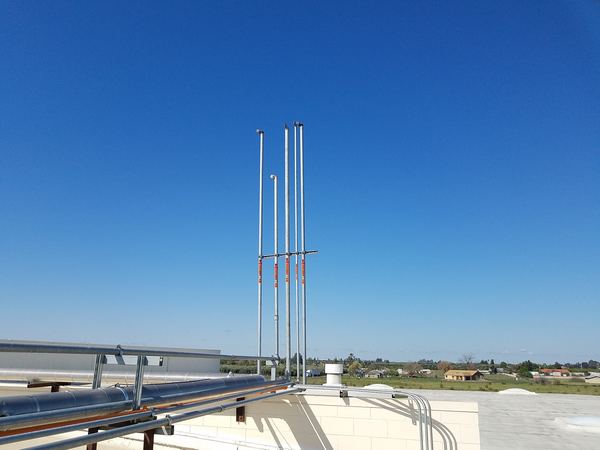RAGAGEP: Historical Variants and the Importance of IIAR Standards | Part 5: Ammonia Discharge Termination

Uriah Donaldson, OHST, presented a technical paper at the 2019 RETA National Conference and 2021 IIAR National Conference titled RAGAGEP: Historical Variants and the Importance of IIAR Standards.
This is the fifth post in a series of blogs which include excerpts from his technical paper.
Ammonia Discharge Termination
In the 1970s, the first language to set the foundation for later diffusion tank requirements appeared in the Uniform Fire Code. The 1971 version of the UFC, in the section detailing “ammonia diffusion” requirements (i.e., emergency control boxes), allowed for atmospheric diffusion or the discharge of ammonia into a “tank of fresh water.”[1] In 1982 the Uniform Fire Code went further and became the first publication to no longer allow an option of simple atmospheric diffusion but rather required the emergency discharge be into an “approved water storage tank, water basin or diffuser having a capacity of 2 gallons of water for each pound of ammonia.”[2]
In the 1994 Uniform Mechanical and Fire Codes the language for emergency control boxes evolved to specifically require a diffusion (or adsorption) tank. Following earlier editions of the Uniform Fire Code, the requirement for both the UMC and UFC was for the water tank to hold at least one gallon of fresh water for every pound of ammonia.[3]
For states which adopted the codes developed and published by the International Code Council (ICC), the International Fire Code reduced the capacity requirement in its 2000 publication to “At least one (1) gallon (3.785 L) of fresh water… for each pound (454 g) of ammonia that will be released in one (1) hour from the largest relief device connected to the discharge pipe.”[4]
In 2003, the National Fire Protection Association updated its fire prevention code, NFPA 1 (aka the Uniform Fire Code), to match the IFC requirement of “1 gal of water for each pound of ammonia that will be released in 1 hour from the largest relief device connected to the discharge pipe.” The UMC followed suit three editions later in 2009.[5]
In the present day, the two major mechanical codes adopted across the United States default to the standard writing organizations that specialize in refrigeration. With regard to application of ammonia discharge and relief valve termination, the most recent published version of the International Mechanical Code (2018) refers to ASHRAE 15 for ammonia discharge while the Uniform Mechanical Code states that ammonia systems need to comply with IIAR 2 for design.[6] Since the 2019 version of ASHRAE 15 explicitly excludes ammonia,[7] IIAR 2 has become the default. IIAR 2 allows for water diffusion systems but prioritizes atmospheric diffusion.[8]
The International Fire Code states that ammonia refrigeration systems “shall discharge vapor to the atmosphere in accordance with” one of five (5) options. The first option listed is to discharge “Directly to atmosphere where the fire code official determines, on review of an engineering analysis prepared in accordance with Section 104.7.2, that a fire, health or environmental hazard would not result from atmospheric discharge of ammonia.”[9]
The Uniform Fire Code is the sole major code which has not been as quick to relinquish control over ammonia diffusion systems. The 2018 version of NFPA 1 still defaults to requiring ammonia diffusion systems unless the owner can prove that atmospheric diffusion will not result in significant fire, health, or environmental hazards.
“Unless the AHJ [authority having jurisdiction] determines, upon review of an engineering analysis prepared at the expense of the owner, that a significant fire, health, or environmental hazard would not result from an atmospheric release, refrigeration systems that are designed to discharge refrigerant vapor to the atmosphere shall be provided with an approved treatment, flaring, or diffusion system where required by 53.2.2.1.1 through 53.2.2.1.3.”[10]
[1] 1971 UFC §28.106(a)
[2] 1982 UFC §63.108(a) Emergency Ammonia Diffusion Systems
[3] 1994 UMC §1119; 1994 UFC §6308.1.1, §6309 Ammonia Discharge
[4] 2000 IFC §606.11.6 Ammonia Diffusion Systems
[5] 2003 NFPA 1 §53.9.1 Ammonia Diffusion Systems; 2009 UMC §1120.0 Ammonia Discharge
[6] 2018 IMC §1105.8 Ammonia Discharge, 2018 UMC §1102.2 Ammonia Refrigeration Systems
[7] ASHRAE 15-2019 §2.3
[8] ANSI/IIAR 2-2014 Addendum A §15.5.1 Atmospheric Discharge; ANSI/ASHRAE 15-2016 §9.7.8.4.2 Ammonia
[9] 2018 IFC §605.12.4 Ammonia Refrigerant
[10] 2018 NFPA 1 §53.2.2.1
The previous blogs are available in the following links:
- Part 1: Introduction
- Part 2: Defining RAGAGEP and Historical Perspectives
- Part 3: The IIAR’s Vision for the Future
- Part 4: Emergency Shutdown Controls

Leave a Reply